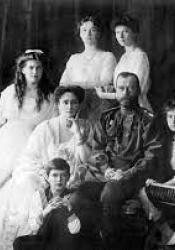Romanov Family Executed
The Romanov family ruled over Russia from 1613 until 1917. During the last leader, Nicholas II’s, rule Russia was involved in a time of near constant war, between the Russo-Japanese war and World War I. This led to economic unrest in the country, with food scarcity and extreme discontent from soldiers and civilians. Nicholas abdicated the throne in 1917 in the face of revolution and a civil war. The Bolsheviks, led by Vladimir Lenin, assumed power soon after (History).
On July 16th, 1918, during a clash between forces in Yekaterinburg, it was decided by the Bolsheviks that the entire Romanov family would be executed. The family and their servants were lined up and posed for a family photo by force. Then, the family was executed by firing squad, with any survivors searched out stabbed to death after the smoke from the guns had cleared (History). Erin Blakemore describes this as a carefully planned attack, saying, “For days, the Romanovs’ Bolshevik captors had been preparing the house for the murder, including stocking up on benzene with which to burn the corpses and sulfuric acid with which to maim them beyond recognition” (Blakemore). Rumors circulated afterward of members of the family having escaped the attack. According to the History.com Editors, “The Crown Prince Alexei and one Romanov daughter were not accounted for, fueling the persistent legend that Anastasia, the youngest Romanov daughter, had survived the execution of her family” (History). There were also similar suspicions of the only son of Nicholas II, Alexis, surviving the execution. However, tangible proof to suggest there were any survivors has yet to be discovered.
From the very beginning of Jasper Fforde’s, The Eyre Affair, the audience is thrust into a world both unfamiliar and absurd. We are introduced to science-fiction levels of weird, with Chrono-Guards, feuding timelines, and a father with, “a face that could stop a clock” literally (Fforde 3). With little to hang onto to center us in this novel, Fforde provides a few timeline revisions that attempts to help the reader become situated to the difference of this world. The most obvious and helpful, perhaps, was the inclusion of “Czar Romanov Alexei IV” (Fforde 9). As this novel takes place in the 1980s, it is likely that this refers to the last son of Nicholas II, who was 13 at the time of the execution (Encyclopedia Britannica). This could imply that either the son actually did manage to escape the murders, or that they never happened in the first place. Regardless, this significant revision in the real world timeline helps the audience become acclimated to the weird, fictional world Thursday operates in.
Looking into the history of the Romanov family, it is also interesting to consider the amount of war connected to Nicholas II and the PTSD Thursday deals with as a veteran of the Crimean war. While not directly connected, there seems to be a theme in Thursday’s world of war and bloodshed, like that tied to the Romanov family and Nicholas II’s rule. This may be worthwhile to keep in mind throughout the reminder of the novel.
Works Cited:
Blakemore, Erin. “Why Czar Nicholas II and the Romanovs Were Murdered” History.com. 29 March 2019. https://www.history.com/news/romanov-family-murder-execution-reasons. Accessed 10 April 2022.
Britannica, The Editors of Encyclopedia. "Alexis Prince of Russia" Encyclopedia Britannica. 21 August 2021. https://www.britannica.com/biography/Alexis-prince-of-Russia-1904-1918. Accessed 10 April 2022.
Family Nicholas II of Russia ca. 1914. Wikimedia Commons. https://commons.wikimedia.org/wiki/File:Family_Nicholas_II_of_Russia_ca._1914.jpg. Accessed 10 April 2022.
Fforde, Jasper. The Eyre Affair. Penguin Books, 2001.
History.com Editors. “Romanov Family Executed, Ending A 300-Year Imperial Dynasty” History.com. 13 January 2021. https://www.history.com/this-day-in-history/romanov-family-executed. Accessed 10 April 2022.

